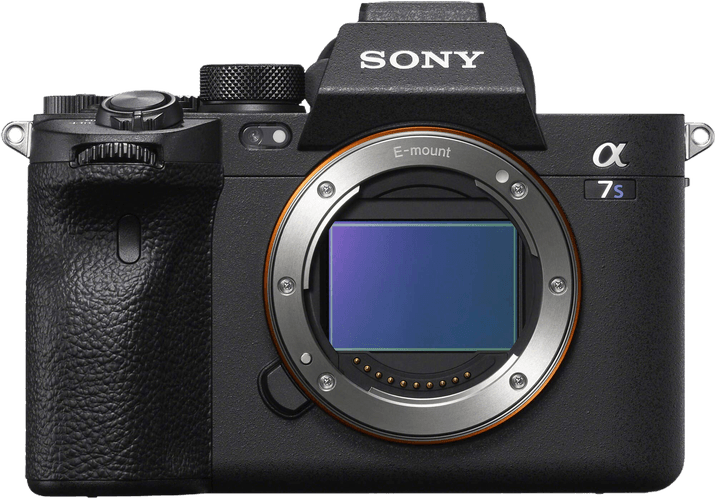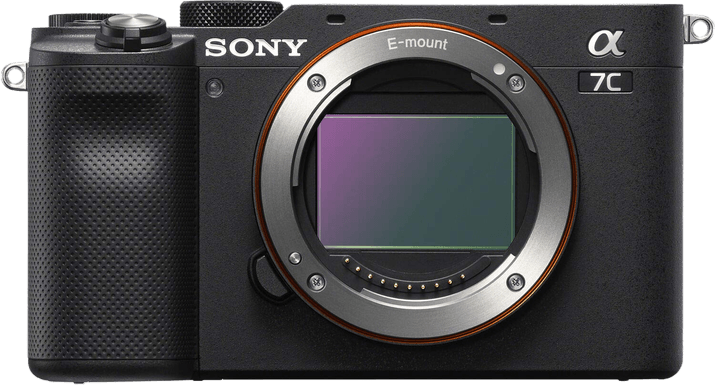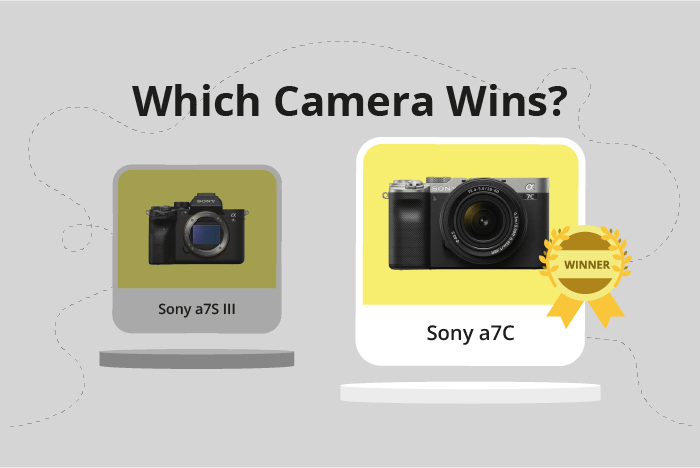Sony a7S III vs a7C Comparison
Sony a7S III

Sony a7C

The Sony a7C emerges as the winner with a score of 78/100, while the Sony a7S III scores 74/100. Both cameras are mirrorless and were released in 2020. They share similarities in their camera type and release year.
The Sony a7C has a smaller size (124 x 71 x 60mm) and is lighter (509g) compared to the Sony a7S III (129 x 97 x 81mm, 699g), making it more portable. Additionally, the a7C has a lower launch price of $1799 compared to the a7S III’s $3499.
On the other hand, the Sony a7S III has a better overall performance and advanced features, justifying its higher price.
Considering the specifications and scores, the Sony a7C is the better option for those prioritizing portability and affordability, while the Sony a7S III is suitable for users seeking higher performance and advanced features.
Sony a7S III vs a7C Overview and Optics
The Sony a7C outperforms the Sony a7S III in optics with a score of 80/100 compared to the a7S III’s 69/100. Both cameras share several specifications, including a full-frame CMOS sensor, Sony FE lens mount, and built-in image stabilization. They also have the same shooting speed of 10 frames per second.
The a7C’s superiority in optics is due to its higher resolution 24.2-megapixel sensor, which enables the camera to capture more detail and produce better image quality. Additionally, the a7C has a higher DXOMARK score of 95 for its sensor, indicating better overall performance in areas such as dynamic range, color depth, and low light capabilities.
On the other hand, the Sony a7S III has a 12.1-megapixel sensor, which may seem inferior but offers advantages in specific situations. The lower resolution allows for larger pixels on the sensor, resulting in better low light performance and reduced noise in images. Furthermore, the a7S III features the more advanced Bionz XR processor, which provides faster image processing and better overall performance.
While the Sony a7C is the clear winner in optics, the Sony a7S III has its strengths and may be more suitable for certain users. The a7C’s higher resolution and better sensor performance make it an excellent choice for photographers seeking superior image quality. However, the a7S III’s lower resolution and advanced processor might be more appealing to those who prioritize low light performance and fast image processing.
Both cameras have their advantages and cater to different needs, making them suitable choices depending on individual preferences and requirements.
Sony a7S III vs a7C Video Performance
The Sony a7S III emerges as the winner in this comparison, scoring 77/100 in video capabilities, while the Sony a7C scores 70/100. Both cameras share some common specifications, such as a maximum video resolution of 4K and video dimensions of 3840 x 2160. However, there are notable differences in their video features that contribute to the difference in scores.
The Sony a7S III outperforms the a7C in terms of maximum video frame rate, offering 120fps compared to the a7C’s 30fps. This higher frame rate allows for smoother and more detailed slow-motion footage, making the a7S III a better choice for videographers who require this functionality. Additionally, the a7S III provides better low-light performance and a wider dynamic range, which contributes to its higher video score.
On the other hand, the Sony a7C has a built-in time-lapse functionality, which the a7S III lacks. This feature enables users to create time-lapse videos without the need for external software or equipment, giving the a7C an advantage in this area.
Taking these factors into consideration, the Sony a7S III is the superior choice for those who prioritize high-quality video performance, particularly in terms of frame rate and low-light capabilities. However, the Sony a7C may be more appealing to those who value the convenience of built-in time-lapse functionality. Ultimately, the choice between these two cameras will depend on the specific video requirements and preferences of the user.
Sony a7S III vs a7C Features and Benefits
The Sony a7S III wins the features comparison with a score of 83/100, while the Sony a7C scores 81/100. Both cameras share several common specifications, including a 3-inch screen, touchscreen functionality, flip screen, GPS, WiFi, and Bluetooth capabilities.
The Sony a7S III outperforms the a7C with its screen resolution, offering 1,440,000 dots compared to the a7C’s 921,600 dots. This higher resolution provides clearer and sharper image previews, allowing for more precise focusing and framing. This advantage makes the a7S III a better choice for photographers who prioritize image quality and accurate composition.
Despite the lower score, the Sony a7C has its own benefits. While it may not be superior in any specific feature, the a7C’s overall performance is still impressive. Its slightly lower score does not detract from the camera’s quality, and it remains a reliable option for photographers looking for a compact and versatile camera. Additionally, the a7C may be more affordable than the a7S III, making it a more attractive option for budget-conscious buyers.
Considering the points above, the Sony a7S III is the better camera in terms of features, particularly due to its higher screen resolution. However, the Sony a7C is still a strong contender, offering similar specifications and a more affordable price point. Ultimately, the choice between these two cameras will depend on individual preferences and priorities, such as image quality, features, and budget.
Sony a7S III vs a7C Storage and Battery
The Sony a7S III outperforms the Sony a7C in storage and battery with a score of 76/100, while the a7C scores 45/100. Both cameras accept SD, SDHC, and SDXC (UHS-II compatible) memory cards and use the NP-FZ100 battery type. Additionally, both cameras offer USB charging capabilities.
The a7S III surpasses the a7C with its dual memory card slots, which accept both SD cards and CFexpress Type A cards. This feature provides greater storage flexibility and faster write speeds, making it more suitable for professional use.
On the other hand, the a7C has a longer battery life, offering 740 shots compared to the a7S III’s 600 shots. This advantage may appeal to those who prioritize extended shooting sessions without frequently changing batteries.
Taking these factors into account, the Sony a7S III proves to be a better choice for professionals who require versatile storage options and faster performance. However, the Sony a7C may be more suitable for casual users who value longer battery life.
Alternatives to the Sony a7S III and a7C
Are you still undecided about which camera is right for you? Have a look at these popular comparisons that feature the Sony a7S III or the Sony a7C:

